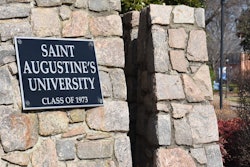Southern Law Center’s Increasing White Enrollment Concerns Lawmaker
By Scott Dyer
BATON ROUGE, La.
One of the most powerful African Americans in the Louisiana Legislature is warning that historically Black Southern University Law Center may be turning too White.
Caucasian students accounted for 33 percent of the Baton Rouge law school’s total enrollment for the 2002-2003 academic year, while 65 percent of the student body was African American. Other races accounted for the remaining 2 percent.
But state Rep. Arthur Morrell, a Democrat from New Orleans who chairs the Louisiana Legislative Black Caucus, said he is concerned that the growing White enrollment may displace prospective Black law students.
“That school was created for a reason, and if that reason is dissipating, what’s going to happen to the minorities who want to attend law school but can’t get in?” Morrell asked.
Morrell said when he attended Southern University law school years ago, it was only about 10 percent White.
“What’s going to happen if you get 60 or 70 percent White? Is it still going to be considered a historically Black law school?” Morrell asked. “The historical mission isn’t being accomplished when there are more and more non-minority students being admitted,” Morrell said.
Southern Law Center Chancellor Freddie Pitcher Jr. said he was surprised at Morrell’s attack, which came at a state legislative budget hearing. Pitcher said the school’s diversity should be applauded, not criticized.
“We have one of the most diverse law schools in the nation, and it’s good for Southern University and it’s good for Louisiana,” Pitcher says. “It’s a great mixture, and folks are getting along fine.”
In addition to producing most of Louisiana’s Black attorney and judges, the law center has produced a number of White judges, lawmakers and district attorneys, Pitcher said.
Among the White students who are currently attending Southern University Law Center is Louisiana Governor Mike Foster, who said he’s not aware of race ever emerging as an issue during the three years that he has attended the school on a part-time basis.
“I’m very comfortable going there,” Foster says. “I wear my blue jeans to class, and everyone really goes out of their way to make me feel like I fit in.”
The governor applauded the Southern Law Center for giving him a chance to study law, even though he’s in his 70s. The state’s other public law school, LSU, is also located in Baton Rouge, but insists that most students refrain from working their first year.
Now in his third year of part-time study at Southern Law Center, Foster said he plans to continue at the school when he leaves office in January. Under Louisiana law, a governor cannot serve more than two consecutive terms. Foster is a Republican who drew criticism when he was elected because his ancestors owned slaves.
But Foster said his relationships with African Americans, including most members of the state Legislative Black Caucus, have improved dramatically since he started taking classes at Southern Law Center.
According to Pitcher, in addition to the study of law, the law school’s diversity gives students a chance to learn how to interact with people from different backgrounds and develop professional relationships that will last as they graduate and practice law.
The governor has had a chance to learn a lot about African Americans by taking classes at the law school and studying with other students after class, Pitcher said.
“He’s hosted study groups at the Governor’s Mansion, and that’s also given many of our African American students an opportunity to see a side of the governor that they wouldn’t normally see,” Pitcher says.
Pitcher thinks Morrell may be “caught in a time warp,” noting that when the Southern Law Center was first founded back in the late 1940s, it was one of the only places that African Americans could go to study law.
“But I think our doors were always open to everyone, even then. I don’t think the founders of the law center would have turned Whites away even back then, if they had decided to come. But they didn’t decide to come until the late 1960s,” Pitcher says.
A 20-Year Trend
Southern University Law Center isn’t the only historically Black law school that is drawing large numbers of White students. Percy R. Luney Jr., dean of Florida A&M University College of Law, said the whitening of historically Black law schools is a 20-year trend.
Luney noted that the FAMU law school was established in 1949 to accommodate African Americans who insisted on their right to a legal education. When Whites began applying to the school in the 1960s, the Florida Board of Regents demanded that all Caucasian students’ applications be forwarded to their office, where they were all rejected, Luney said.
The FAMU law school was finally closed in 1968, when the Florida Legislature shifted the funds to the other side of Tallahassee to establish a law school at the predominantly White Florida State University.
The historically Black law school reopened last year in Orlando with a student body that was 42 percent African American, 45 percent Caucasian and 7 percent Hispanic. The rest were other races, or chose not to indicate their race, according to the school’s records (see Black Issues, June 20, 2002).
Luney said he’s proud of the resurging school’s diversity. In addition to growing White enrollment, Luney said another national trend at historically Black law schools is an increasing female enrollment.
Females now outnumber males on many historically Black law schools because nearly twice as many African American females are now taking the LSAT as African American males, Luney said.
At FAMU law school, 55 of the 89 students in last year’s inaugural class were women.
Luney noted that Foster is not the only White Southern governor to attend a historically Black law school. North Carolina Gov. Mike Easley is a graduate of historical Black North Carolina Central University School of Law, Luney said. Easley’s wife Mary now serves as a professor of law at the school.
Luney is familiar with North Carolina Central’s law school because he served as dean there before coming to FAMU. For the past 20 years, enrollment at the historically Black North Carolina school has generally ranged from 55 to 60 percent African American, and 40 to 45 percent White, Luney said. But he noted that North Carolina Central’s law school operates an evening program that is 75 percent to 80 percent White and 20 percent to 25 percent Black.
Following the Courts
Under Florida law, neither race nor gender can legally be considered when a law school reviews applications for prospective students. And a U.S. Supreme Court decision is pending on college affirmative action programs.
Pitcher said that due to recent court rulings, Southern University Law Center doesn’t look at race when sorting through the 1,300 to 1,400 applications each year to choose 150 freshmen slots.
Pitcher said the law school has to comply with the standards set by the American Bar Association and federal laws against racial discrimination. In choosing a freshman class, the committee looks closely at college grades and LSAT pre-law test scores, but also considers other factors.
“We also look at life experiences and other factors to determine who should fill these slots that we have available,” Pitcher says.
Since 1994, Louisiana has been operating under court-supervised settlement to resolve a long-running federal lawsuit over racial segregation of its public higher education system.
That settlement has forced the creation of several graduate school programs at historically Black universities to attract White students. But none has been as successful, in terms of diversity, as the law center. And undergraduate programs at Grambling State and Southern University’s Baton Rouge campus have seen little change in White enrollment over the past nine years.
“It’s an easier sell than undergraduate programs, because students recognize that after matriculating at Southern or Texas Southern or Howard (law schools), that they’re going to get the same opportunity to take that bar exam as everybody else,” Pitcher says. “And once that happens, they are out there competing with everybody else.”
© Copyright 2005 by DiverseEducation.com















